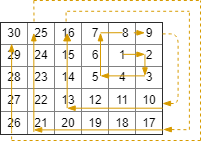Welcome to Subscribe On Youtube
885. Spiral Matrix III
Description
You start at the cell (rStart, cStart) of an rows x cols grid facing east. The northwest corner is at the first row and column in the grid, and the southeast corner is at the last row and column.
You will walk in a clockwise spiral shape to visit every position in this grid. Whenever you move outside the grid's boundary, we continue our walk outside the grid (but may return to the grid boundary later.). Eventually, we reach all rows * cols spaces of the grid.
Return an array of coordinates representing the positions of the grid in the order you visited them.
Example 1:

Input: rows = 1, cols = 4, rStart = 0, cStart = 0 Output: [[0,0],[0,1],[0,2],[0,3]]
Example 2:

Input: rows = 5, cols = 6, rStart = 1, cStart = 4 Output: [[1,4],[1,5],[2,5],[2,4],[2,3],[1,3],[0,3],[0,4],[0,5],[3,5],[3,4],[3,3],[3,2],[2,2],[1,2],[0,2],[4,5],[4,4],[4,3],[4,2],[4,1],[3,1],[2,1],[1,1],[0,1],[4,0],[3,0],[2,0],[1,0],[0,0]]
Constraints:
1 <= rows, cols <= 1000 <= rStart < rows0 <= cStart < cols
Solutions
-
class Solution { public int[][] spiralMatrixIII(int rows, int cols, int rStart, int cStart) { int cnt = rows * cols; int[][] ans = new int[cnt][2]; ans[0] = new int[] {rStart, cStart}; if (cnt == 1) { return ans; } for (int k = 1, idx = 1;; k += 2) { int[][] dirs = new int[][] { {0, 1, k}, {1, 0, k}, {0, -1, k + 1}, {-1, 0, k + 1} }; for (int[] dir : dirs) { int r = dir[0], c = dir[1], dk = dir[2]; while (dk-- > 0) { rStart += r; cStart += c; if (rStart >= 0 && rStart < rows && cStart >= 0 && cStart < cols) { ans[idx++] = new int[] {rStart, cStart}; if (idx == cnt) { return ans; } } } } } } } -
class Solution { public: vector<vector<int>> spiralMatrixIII(int rows, int cols, int rStart, int cStart) { int cnt = rows * cols; vector<vector<int>> ans; ans.push_back({rStart, cStart}); if (cnt == 1) return ans; for (int k = 1;; k += 2) { vector<vector<int>> dirs = { {0, 1, k}, {1, 0, k}, {0, -1, k + 1}, {-1, 0, k + 1} }; for (auto& dir : dirs) { int r = dir[0], c = dir[1], dk = dir[2]; while (dk-- > 0) { rStart += r; cStart += c; if (rStart >= 0 && rStart < rows && cStart >= 0 && cStart < cols) { ans.push_back({rStart, cStart}); if (ans.size() == cnt) return ans; } } } } } }; -
class Solution: def spiralMatrixIII( self, rows: int, cols: int, rStart: int, cStart: int ) -> List[List[int]]: ans = [[rStart, cStart]] if rows * cols == 1: return ans k = 1 while True: for dr, dc, dk in [[0, 1, k], [1, 0, k], [0, -1, k + 1], [-1, 0, k + 1]]: for _ in range(dk): rStart += dr cStart += dc if 0 <= rStart < rows and 0 <= cStart < cols: ans.append([rStart, cStart]) if len(ans) == rows * cols: return ans k += 2 -
func spiralMatrixIII(rows int, cols int, rStart int, cStart int) [][]int { cnt := rows * cols ans := [][]int{[]int{rStart, cStart} } if cnt == 1 { return ans } for k := 1; ; k += 2 { dirs := [][]int{ {0, 1, k}, {1, 0, k}, {0, -1, k + 1}, {-1, 0, k + 1} } for _, dir := range dirs { r, c, dk := dir[0], dir[1], dir[2] for dk > 0 { rStart += r cStart += c if rStart >= 0 && rStart < rows && cStart >= 0 && cStart < cols { ans = append(ans, []int{rStart, cStart}) if len(ans) == cnt { return ans } } dk-- } } } }